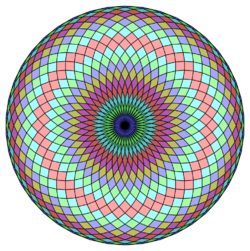Tetracontadigon
| Regular tetracontadigon | |
|---|---|
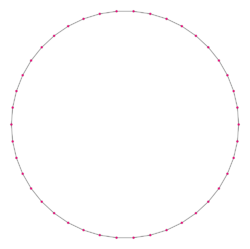 A regular tetracontadigon | |
| Type | Regular polygon |
| Edges and vertices | 42 |
| Schläfli symbol | {42}, t{21} |
| Coxeter diagram | |
| Symmetry group | Dihedral (D42), order 2×42 |
| Internal angle (degrees) | ≈171.429° |
| Dual polygon | Self |
| Properties | Convex, cyclic, equilateral, isogonal, isotoxal |
In geometry, a tetracontadigon (or tetracontakaidigon) or 42-gon is a forty-two-sided polygon. (In Greek, the prefix tetraconta- means 40 and di- means 2.) The sum of any tetracontadigon's interior angles is 7200 degrees.
Regular tetracontadigon
The regular tetracontadigon can be constructed as a truncated icosihenagon, t{21}.
One interior angle in a regular tetracontadigon is 1713⁄7°, meaning that one exterior angle would be 84⁄7°.
The area of a regular tetracontadigon is (with t = edge length)
- [math]\displaystyle{ A = 10.5t^2 \cot \frac{\pi}{42} }[/math]
and its inradius is
- [math]\displaystyle{ r = \frac{1}{2}t \cot \frac{\pi}{42} }[/math]
The circumradius of a regular tetracontadigon is
- [math]\displaystyle{ R = \frac{1}{2}t \csc \frac{\pi}{42} }[/math]
Since 42 = 2 × 3 × 7, a regular tetracontadigon is not constructible using a compass and straightedge,[1] but is constructible if the use of an angle trisector is allowed.[2]
Symmetry
The regular tetracontadigon has Dih42 dihedral symmetry, order 84, represented by 42 lines of reflection. Dih42 has 7 dihedral subgroups: Dih21, (Dih14, Dih7), (Dih6, Dih3), and (Dih2, Dih1) and 8 more cyclic symmetries: (Z42, Z21), (Z14, Z7), (Z6, Z3), and (Z2, Z1), with Zn representing π/n radian rotational symmetry.
These 16 symmetries generate 20 unique symmetries on the regular tetracontadigon. John Conway labels these lower symmetries with a letter and order of the symmetry follows the letter.[3] He gives r84 for the full reflective symmetry, Dih42, and a1 for no symmetry. He gives d (diagonal) with mirror lines through vertices, p with mirror lines through edges (perpendicular), i with mirror lines through both vertices and edges, and g for rotational symmetry. a1 labels no symmetry.
These lower symmetries allows degrees of freedoms in defining irregular tetracontadigons. Only the g42 subgroup has no degrees of freedom but can seen as directed edges.
Dissection
Coxeter states that every zonogon (a 2m-gon whose opposite sides are parallel and of equal length) can be dissected into m(m-1)/2 parallelograms.[4] In particular this is true for regular polygons with evenly many sides, in which case the parallelograms are all rhombi. For the regular tetracontatetragon, m=21, it can be divided into 210: 10 sets of 21 rhombs. This decomposition is based on a Petrie polygon projection of a 21-cube.

|
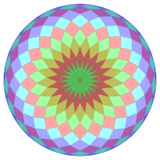
|
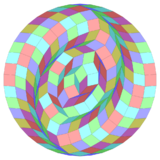
|

|
Related polygons
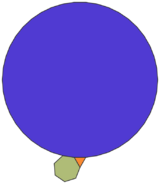
An equilateral triangle, a regular heptagon, and a regular tetracontadigon can completely fill a plane vertex. However, the entire plane cannot be tiled with regular polygons while including this vertex figure,[5] although it can be used in a tiling with equilateral polygons and rhombi.[6]
Tetracontadigram
A tetracontadigram is a 42-sided star polygon. There are five regular forms given by Schläfli symbols {42/5}, {42/11}, {42/13}, {42/17}, and {42/19}, as well as 15 compound star figures with the same vertex configuration.
| Picture | 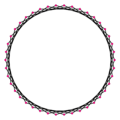 {42/5} |
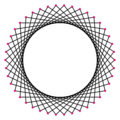 {42/11} |
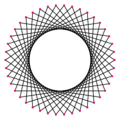 {42/13} |
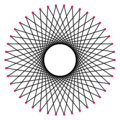 {42/17} |
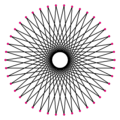 {42/19} |
|---|---|---|---|---|---|
| Interior angle | ≈137.143° | ≈85.7143° | ≈68.5714° | ≈34.2857° | ≈17.1429° |
References
- ↑ Constructible Polygon
- ↑ "Archived copy". Archived from the original on 2015-07-14. https://web.archive.org/web/20150714082609/http://www.math.iastate.edu/thesisarchive/MSM/EekhoffMSMSS07.pdf. Retrieved 2015-02-19.
- ↑ John H. Conway, Heidi Burgiel, Chaim Goodman-Strauss, (2008) The Symmetries of Things, ISBN 978-1-56881-220-5 (Chapter 20, Generalized Schaefli symbols, Types of symmetry of a polygon pp. 275-278)
- ↑ Coxeter, Mathematical recreations and Essays, Thirteenth edition, p.141
- ↑ [1] Topics in Mathematics for Elementary Teachers: A Technology-enhanced ... By Sergei Abramovich
- ↑ Shield - a 3.7.42 tiling

